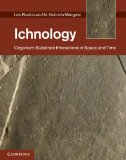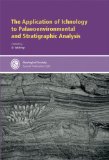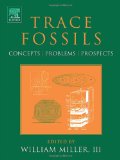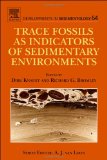Ichnology
- A diverse ichnofauna from the Cambrian Stage 4 Wulongqing Formation near Kunming (Yunnan Province, South China)

- A Diverse Upper Jurassic Dinosaur Ichnofauna From Central-west Portugal: Upper Jurassic Dinosaur Ichnofauna From Central-west Portugal

- A framework of ichthyofaunal ecostratigraphy of the Oligocene-Early Miocene strata of the Polish Outer Carpathian basin

- A highly diverse ichnofauna in Late Triassic deep-sea fan deposits of Oman

- A mixed assemblage of deep-sea and shelf trace fossils from the Lower Cretaceous (Valanginian) Kamchia Formation in the Troyan region, central Fore-Balkan, Bulgaria

- A new decapod burrow system from the NW Mediterranean Pliocene

- A rich ichnofossil assemblage from the Frasnian (Upper Devonian) deposits at Andoma Hill, Onega Lake, Russia

- Additional note to new trace fossils produced by etching molluscs from the Upper Neogene of the southwestern Iberian Peninsula

- An event bed with abundant Skolithos burrows from the late Pridoli (Silurian) of Saaremaa (Estonia)

- Arachnostega Bertling, 1992 in the Drumian (Cambrian) sediments of the Teplá-Barrandian region (Czech Republic)

- Arthropod trace fossil Cruziana and associated ichnotaxa from the Lower Permian Abo Formation, Socorro County, New Mexico

- Between a rock and a hard place: arthropod trackways and ichnotaxonomy

- Biogenic sedimentary structures in mudstones - An overview

- Bioturbation and biogenic sedimentary structures in contourites

- Bioturbation structures in the Holovnia Siliceous Marls (Turonian-lower Santonian) in Rybotycze (Polish Carpathians)

- Continental Ichnology Research Laboratory (CIRL)
- Cretaceous ophiuroid trace-fossils form the Neuquen Basin, Argentina

- Cruziana traces from the Late Silurian (Pridoli) carbonate shelf of Saaremaa, Estonia

- Da Vinci’s Paleodictyon: the fractal beauty of traces

- Deep-sea benthic food content recorded by ichnofabrics; a conceptual model based on observations from Paleogene flysch, Carpathians, Poland

- Deep-sea ichnology: Observations in modern sediments to interpret fossil counterparts

- Early Permian ichnofossil assemblage from the Fra Cristobal Mountains, southern New Mexico

- Ecologic interpretation of deep-sea trace fossil communities

- Eocene graphoglyptids from shallow-marine, highenergy, organic-rich, and bioturbated turbidites, Fuegian Andes, Argentina

- Exploring the aftermath of the Cambrian explosion: The evolutionary significance of marginal- to shallow-marine ichnofaunas of Jordan

- First records of trace fossils from the Lake District, southwestern Turkey

- Fluvial and eolian ichnofaunas from the Lower Permian of South America (Patquía Formation, Paganzo Basin)

- Fluvial trace fossils in the Middle Siwalik (Sarmatian-Pontian) of Darjeeling Himalayas, India

- Geographic Information Systems for ichnofabric analysis: modelling a modern lagoon (Grado, Italy) with the IchnoGIS method

- Ichnia 2012 - Third International Congress on Ichnology, 9 - 24 August, 2012, St. John’s, Canada
- Ichnocoenoses in the Oligocene to Miocene foredeep basins (Northern Apennines, central Italy) and their relation to turbidite deposition

- Ichnofabrics of the Pliocene marginal marine basins of the northwestern Mediterranean

- Ichnofabrics of the Upper Cretaceous marlstones in the Opole region, southern Poland

- Ichnofacies concept in vertebrate ichnology

- Ichnofauna from the Upper Carboniferous-Lower Permian rhythmites from Mafra, Santa Catarina State, Brazil: ichnotaxonomy

- Ichnological analysis of an Eocene mixed marly-siliciclastic flysch deposits in the Nienadowa Marl Member, Skole Unit, Polish Flysch Carpathians

- Ichnological record of the activity of Anthozoa in the early Cambrian succession of the Upper Silesian Block (southern Poland)

- Ichnology of Czarna Shale Formation (Cambrian, Holy Cross Mountains, Poland)

- Ichnology of Deltas: Organism Responses to the Dynamic Interplay of Rivers, Waves, Storms and Tides

- Ichnology of the Early Cambrian Tal Group, Mussoorie Syncline, Lesser Himalaya, India

- Ichnology of the Miocene Güneyce Formation (Southwest Turkey): Oxygenation and Sedimentation Dynamics

- Ichnology Research Group (IRG)
- International Ichnological Association
- Kiss of death of a hunting fish: trace fossil Osculichnus labialis igen. et isp. nov. from late Eocene – early Oligocene prodelta sediments of the Mezardere Formation, Thrace Basin, NW Turkey

- KU Ichnology
- Lacustrine trace fossils and environmental conditions in the Early Miocene Ermenek Basin, southern Turkey

- Late Carboniferous paleoichnology reveals the oldest full-body impression of a flying insect

- Lowermost Cambrian Ichnofabrics from the Chapel Island Formation, Newfoundland : Implications for Cambrian Substrates

- Morphologic Variations Of The Trace Fossil Rutichnus In Cm-thick Turbidites From The Verghereto Formation (northern Apennines, Italy)

- Morphological variability of the trace fossil Schaubcylindrichnus coronus as a response to environmental forcing

- New trace fossils produced by etching molluscs from the Upper Neogene of the southwestern Iberian Peninsula

- Occurrence of the trace fossil Zoophycos from the Upper Viséan Paprotnia Beds of the Bardo Structural Unit (Sudetes, SW Poland)

- Omanichnus and Vitichnus – two new graphoglyptid ichnogenera from Upper Triassic deep-sea fan deposits in Oman

- Palaeobiological and palaeonvironmental significance of the Pliocene trace fossil Dactyloidites peniculus

- Palaeoecological aspects of some invertebrate trace fossils from the mid- to Upper Permian Middleton Formation (Adelaide Subgroup, Beaufort Group, Karoo Supergroup), Eastern Cape, South Africa

- Paleobiology of the crustacean trace fossil Spongeliomorpha iberica in the Miocene of southeastern Spain

- Paleoecology of the ichnocoenoses in the Cruziana Ichnofacies, Serrinha Member, Rio do Rasto Formation (Upper Permian) from the Paraná Basin, Rio Grand edo Sul, Brazil

- Patterns of occurrence and distribution of crustacean ichnofossils in the Lower Jurassic–Upper Cretaceous of Atlantic occidental margin basins, Portugal

- Proposal For An Uniform Data Standard For Ichnological 3d Tracking And Post-processing

- SED-TRACE - Applied sedimentology and ichnology
- Sedimentary facies, ichnofossils and storm deposits in the Lower Permian Taiyuan Formation, Jiaozuo city, Henan Province, central China

- Sedimentology and ichnology of Bathonian (Middle Jurassic) ore-bearing clays at Gnaszyn, Kraków- Silesia Homocline, Poland

- Significance of Lockeia and associated trace fossils from the Bada Bagh Member, Jaisalmer Formation, Rajasthan

- SLIC 2013 - 2nd Latin American Symposium on Ichnology - September 13th-22nd 2013, Santa Rosa, Argentina
- Stratigraphic completeness: Tiered trace fossils provide a measuring stick

- Systematic ichnology of the Late Ordovician Georgian Bay formation of southern Ontario, eastern Canada

- Taphonomic Aspects Of The Miocene Ichnofossil-lagerstätte From Calcarenite Turbiditic Beds In The Verghereto Marls(northern Apennines, Italy)

- Taxonomy and ethology of flysch trace fossils: revision of the Marian Ksiazkiewicz collection and studies of complementary material

- Three-dimensional reconstruction of "phycosiphoniform" burrows: implications for identification of trace fossils in core

- Three-dimensionally integrated trace fossils from shallow-marine deposits in the Lower Cretaceous of the Neuquén Basin (Argentina): Hillichnus agrioensis isp. nov.

- Trace fossil Cruziana tenella from the Furongian (Upper Cambrian) deposits of Poland

- Trace fossil Lepidenteron lewesiensis (Mantell, 1822) from the Upper Cretaceous of southern Poland

- Trace fossil Rusophycus versans from the Furongian (Upper Cambrian) of central Poland – an example of behavioural convergence amongst arthropods

- Trace fossils accompanying possible “Ediacaran organisms” in the Middle Cambrian sediments of the St. Petersburg Region, Russia

- Trace fossils and substrates of the terminal Proterozoic–Cambrian transition: Implications for the record of early bilaterians and sediment mixing

- Trace fossils from Bhuban Formation, Surma Group (Lower to Middle Miocene) of Mizoram India and their palaeoenvironmental significance

- Trace fossils from Silurian and Devonian turbidites of the Chauvay area, southern Tien Shan, Kyrgyzstan

- Trace fossils from the Lower and Middle Jurassic marginal marine deposits of the Sorthat Formation, Bornholm, Denmark

- Trace fossils from the Lower Muschelkalk of Raciborowice Górne (North Sudetic Synclinorium, SW Poland) and their palaeoenvironmental interpretation

- Trace fossils from the Lower–Middle Jurassic Bardas Blancas Formation, Neuquén Basin, Mendoza Province, Argentina

- Trace fossils from the Talchir carbonate concretions, Giridih Basin, Jharkhand

- Trace fossils in the Cretaceous-Eocene flysch of the Sinop-Boyabat Basin, Central Pontides, Turkey

- Trace fossils of Miocene deep-sea fan fringe deposits from the Cingöz Formation, southern Turkey

- Trace Fossils of the Upper Eocene-Lower Oligocene Transition of the Manipur, Indo-Myanmar Ranges (Northeast India)

- Two episodic changes of trace fossils through the Permian-Triassic transition in the Meishan cores, Zhejiang Province

- Unusual preservation of Ophiomorpha in middle Miocene rocks of Wadi Zablah, east Matruh area, northwestern Egypt

- Use of ichnology in basin environment reconstruction: an example from the Lower Permian Pietra Simona Mb. (Southern Alps, Italy)

- What is the biostratigraphic value of the ichnofossil Oldhamia for the Cambrian: a review

- XII International Ichnofabric Workshop - 30 th June-5 th July 2013, Canakkale/Dardanelles, Turkey
Books about ichnology




